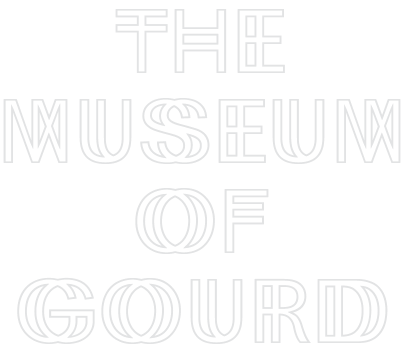The gourd has been used as a container across the world since ancient times. Grown in Africa, Eurasia, Austronesia, and America for more than ten thousand years, it is one of the world’s oldest cultivated plants. Easy to grow and cut, it was sometimes used as a dish, spoon, or a container for water and wine. In China and Japan, the seeds kept in the gourd were believed to be fertile, just as the gourd is itself a symbol of fertility and fluidity. In the Chinese myth of Genesis, it is said that a man and woman survived the Great Flood by using a large gourd as a boat. In eastern Taiwan there are villages where local shamans use the gourd bottle for divination. The first form of the Chinese ideogram for the gourd is found today in the word for “liberty”—for there is no liberty without fluidity and, it seems, no fluidity without the gourd.
Another use of the gourd, which may be as old as that of the container, is as a musical instrument. Its natural shape is an ideal resonator and has been used to make rattles, whistles, and many kinds of drums. Ancient history is often conceived in terms of such things as stone tools. The “Stone Age” is, I think, a particularly modern vision with a very limited perspective, because we do not know whether stone was actually the primary tool of this era. There must have been many more tools that were more important.
For this reason, I would prefer to call it the “Gourd Age.” Migration over land and water would not have been possible without a water container. If the amazing diversity of the gourd family is the result of human migration, then the gourd is one of those things that have sustained our long life on this planet while leaving very little trace of itself. We have shaped gourds and have been shaped by them. We are literally the children of the gourd.
On the question of containers, it is also interesting to reconsider the “Atomic Age” after the great earthquake in Japan.
The Fukushima nuclear disaster revealed not only the limit of our capacity to control nuclear energy but also its paradox: while the reactor generates immense energy, this energy must be totally contained. The reactor liberates the energy without fluidity, since fluidity would release dangerous radioactivity.
The vast contamination and planet-wide pollution following the Fukushima disaster illustrate this paradox. The gourd could be a model for the low-tech culture that will follow high-tech disasters. We have begun to turn our attention to alternative sources of energy from wind and from water—resources that flow freely. If the phenomenon of life is in fact this very flow, then the gourd is one of the oldest models of fluidity. The Hawaiian gourd, for example, symbolizes ocean winds and is also used as a musical instrument for Hawaiian dance.
We would like to offer this mini-museum as a container for (thinking) fluidity and liberty. The Museum of Gourd is a living museum that collects, keeps, and exchanges ideas about containers and the contents of our societies and minds. Some cities have
their psycho-geographical form incorporated into their historical setting—Taipei being one of these cities. In Shilin, the northwestern part of the city, there was once an island called Gourd Island, and we still find its form and its name on one of the streets. The Taipei Fine Arts Museum is located at the mouth of the ancient Gourd Island.
The Museum of Gourd will be composed of a number of sections. One will display the first edition of the Gourd Collection. The world history of the gourd will be traced through mythology, literature, drawing, and photography. The Taiwanese artist Chang Ting-Ya will draw the history through her inside-outside vision. Shiro Takahashi will make a “Big Gourd” with his BABOT technology, to symbolize the fluidity and liberty of our time. Daizaburo Harada, a leading Japanese computer graphic artist, will visualize the form of container-contents architecture.
In addition, Gourd Magazine will be an online magazine published by The Museum of Gourd. It will cover a wide range of topics such as art, design, architecture, and more. Many will be invited to share their gourd stories, which will be archived in the museum.
Finally, the Gourd Shop will sell original products that symbolize our philosophy of fluidity. (Chihiro Minato)
